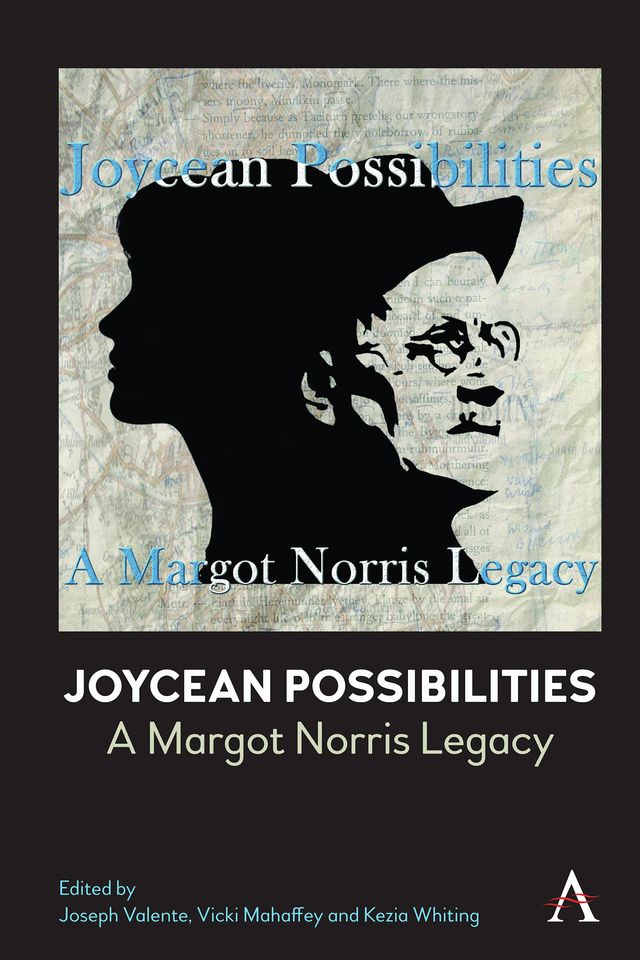Edited by Joseph Valente, Vicki Mahaffey and Kezia Whiting
ISBN: 9781839981005
Pages: 260
Pub Date: December 2022
Imprint: Anthem Press
Edited by Joseph Valente, Vicki Mahaffey and Kezia Whiting
ISBN: 9781839981005
Pages: 260
Pub Date: December 2022
Imprint: Anthem Press
This dedicated volume proposes to honor the rich, varied, trenchant, and tremendously influential scholarship of Professor Margot Norris in a series of essays amplifying her illumination of Joyce’s literary oeuvre along with several prominent lines she introduced and investigated. Our title is intended to mark the common denominator running, like Ariadne’s thread, throughout Professor Norris’ many-sided explorations of Joyce’s labyrinth. For Professor Norris, the quiddity of Joyce’s work, its elusive whatness, resides in its secretion of multiple what elses, its opening up of alternative ways of regarding the novels themselves, the readers they address, the narrative or generic forms they destabilize, the world to which they refer, and the heritages they tap. These five categories, in fact—textual plurivalence, formal innovations, possible worlds, emergent histories, and variegated readerships—serve as anchoring points of the collection, each corresponding with one of the significant projects delineating Professor Norris’ esteemed career. Prominent Joycean, Modernist, and Irish study scholars of different nations and generations supply the essays under each heading.
The first critical section, the textual dimension, will engage with Professor Norris’ exemplary vindication of the hermeneutics of suspicion in her monograph, Suspicious Readings of Joyce’s Dubliners. Joseph Valente, Kezia Whiting and Beryl Schlossman will be toiling in this particular vineyard. The second section, the readerly dimension, will take up Professor Norris’ most recent book, Virgin and Veteran Readings of Ulysses, where she elaborates how the stylistic iridescence that Hugh Kenner identified as essential to Joyce’s writing likewise operates with shifts in the experience (in every sense of the term) of the reader, and how Joyce inscribes that shimmer of interpretive possibility directly into the text itself. Michael Groden, Ellen Carol Jones, and Austin Briggs each contribute an essay on this topic. The third section, the narratological dimension, grows out of Professor Norris’ attention to Joyce’s experiments in narrative and, more broadly, symbolic structure, beginning with her first book on Joyce, The Decentered Universe of Finnegans Wake. Derek Attridge and Valerie Benejan are featured in this subdivision. The fourth section, on alternative realities, enters forthrightly into dialogue with Professor Norris’ recent essays that usher the postmodern “possible worlds theory '' into the orbit of Joyce studies. Gregory Castle, Marilyn Reizbaum and Paul Saint-Amour extend the application of this paradigm to Ulysses and Finnegans Wake respectively. Whereas the first section of the volume deals with the importance of subtext in Professor Norris’ exegetical achievements, the final grouping deals with sub-context, with moments of buried history of the sort Professor Norris addresses in her book, Joyce’s Web. The essayists developing this approach include Maud Ellmann, Ann Fogarty, Michael Gillespie, and Margot Backus.
The volume culminates with an essay by Vicki Mahaffey focusing on the envisioning of and commitment to gender equality that pervades all of Professor Norris’ scholarship and rivets the excavation of a buried past to the imagination of a better future, possibilities missed and possibilities still to be seized.
Hopefully, this roster denotes how the concept of possibility will give the collection, as it has Professor Norris’ research, and as it did Joyce’s literary monuments, a kind of floating foundation (what seismic architects call base isolation), that ensures consistency in and through flexibility. The essays, to shift metaphorical register, speak to one another but in different idioms, each of which Professor Norris herself has helped to make legible and compelling in the several fields where Joyce looms centrally important. Due to the reverence in which Professor Norris is held in the Joyce community, the distinguished reputation of the contributors in Joyce studies and related fields, and the currency of the approaches they take in following her lead, this volume is certain to attract a substantial academic readership.
